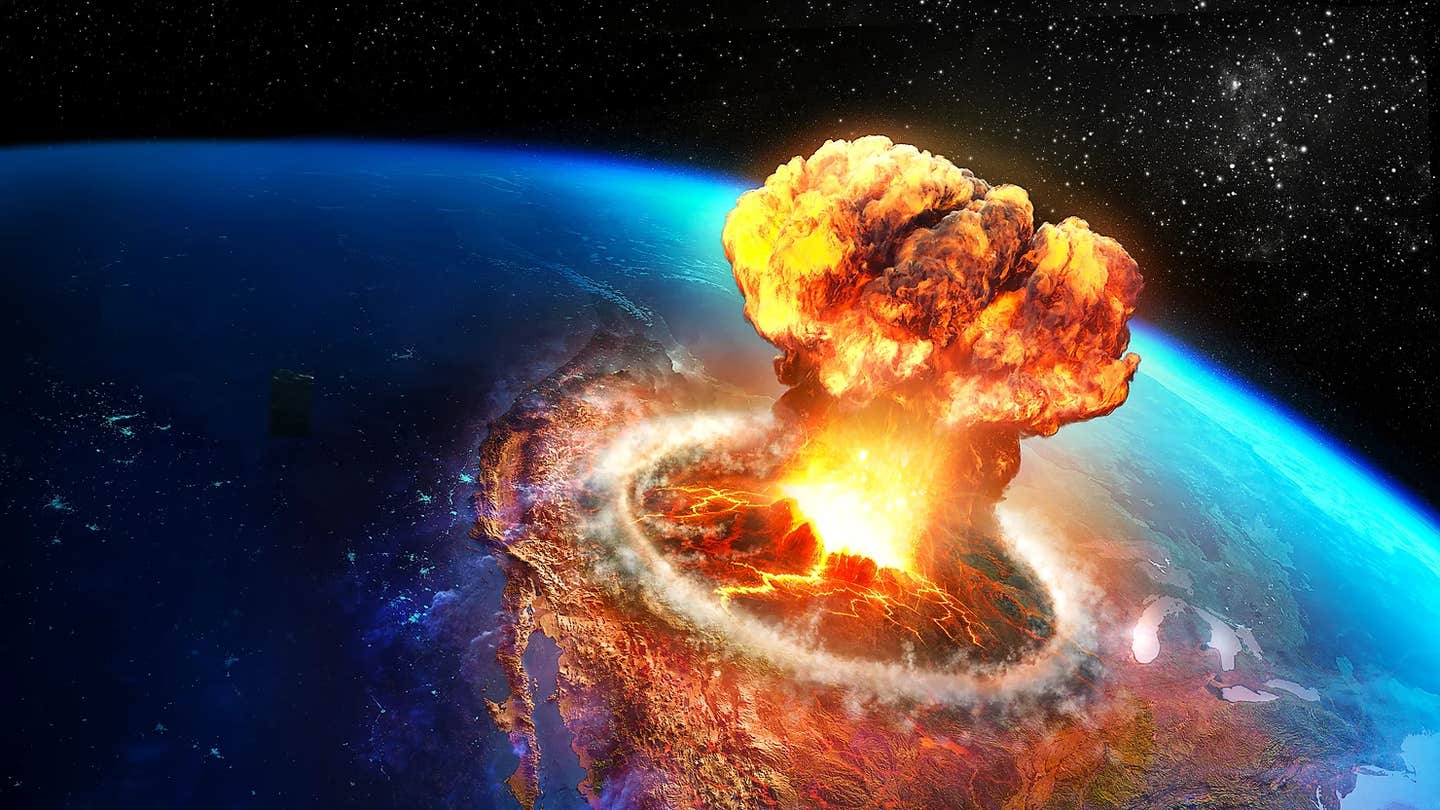How close are we to the next catastrophic supervolcano eruption?
Scientists found that supervolcanoes like Toba remain hazardous for thousands of years after an eruption, challenging current volcanic hazard predictions.

Illustration of a Yellowstone supervolcano eruption seen from an altitude of around 40 km. (CREDIT: Yellowstone Supervolcano: American Doomsday)
A recent international study on an ancient Indonesian supervolcano revealed that these massive volcanic systems remain hazardous for thousands of years after a super-eruption. This new understanding suggests that predicting future volcanic activity may require a shift in approach.
Curtin University's Associate Professor Martin Danišík, who led the Australian contingent of the research team, highlighted how little was known about the periods between eruptions. These dormant phases, spanning tens of thousands of years, hold key information for understanding potential future threats. According to him, "Gaining an understanding of those lengthy dormant periods will determine what we look for in young active supervolcanoes to help us predict future eruptions."
Super-eruptions are among the most extreme natural events in Earth’s history. They eject massive amounts of magma almost instantly, which can disrupt global climate patterns. In some cases, they lead to a phenomenon known as a "volcanic winter," where the Earth's temperature drops significantly, potentially causing widespread famine and societal upheaval.
Understanding how these eruptions work is crucial, as the frequency of such events is around once every 17,000 years. It’s not a matter of if another one will occur, but when.
The team's research focused on the Toba super-eruption, which occurred roughly 75,000 years ago in what is now Indonesia. By analyzing minerals like feldspar and zircon found in volcanic rocks, which act as natural timekeepers through their accumulation of argon and helium gases, they were able to create a clearer picture of what happens after a super-eruption.
Related Stories
Through a combination of geochronological data, statistical models, and thermal analysis, the researchers determined that magma continued to seep out of the caldera—the vast crater left by the eruption—for 5,000 to 13,000 years. This finding, as Danišík pointed out, was unexpected. "The findings challenged existing knowledge and studying of eruptions, which normally involves looking for liquid magma under a volcano to assess future hazard."
Typically, scientists predict volcanic hazards by detecting liquid magma beneath a volcano. This study, however, calls into question that approach. Even if no liquid magma is detected, the remnants of a super-eruption may still pose a significant threat. Danišík emphasized that, "We must now consider that eruptions can occur even if no liquid magma is found underneath a volcano—the concept of what is 'eruptible' needs to be re-evaluated."
One of the most surprising aspects of the research was how the solidified leftover magma continued to shape the landscape. After the initial eruption, the solidified magma, called a "carapace," was slowly pushed upwards over thousands of years, creating formations resembling a giant turtle shell. This process indicates that the danger doesn't end with the initial eruption. Instead, the volcanic system may remain active for thousands of years, with the potential for further hazards.
Danišík emphasized that while super-eruptions can cause global disruptions and require long recovery periods, their lingering dangers are often underestimated. "While a super-eruption can be regionally and globally impactful and recovery may take decades or even centuries, our results show the hazard is not over with the super-eruption and the threat of further hazards exists for many thousands of years after."
Understanding the accumulation of magma before and after an eruption, and determining when it becomes eruptible again, is essential to grasping the full risk posed by supervolcanoes. Danišík’s research highlights the need to reevaluate how we predict volcanic activity and suggests that hazard assessments should consider the long-lasting impacts of magma left beneath the surface.
The study was led by Oregon State University in collaboration with researchers from Heidelberg University, the Geological Agency of Indonesia, and Dr. Jack Gillespie of Curtin's School of Earth and Planetary Sciences. Curtin's Institute for Geoscience Research (TIGeR) also contributed to the findings.
Their work, titled "Resurgence initiation and subsolidus eruption of cold carapace of warm magma at Toba Caldera, Sumatra," was published in the prestigious journal Nature—Earth and Environmental Sciences. This groundbreaking study may change how future volcanic threats are evaluated, giving scientists better tools to predict eruptions and minimize their impact on both local and global scales.
Most recent supervolcano eruptions
The most recent known supervolcano eruptions occurred tens of thousands to millions of years ago, with none in recorded human history. The most recent significant supervolcano events are:
Taupō Volcano (New Zealand) – The last major eruption occurred around 26,500 years ago, known as the Oruanui eruption. It’s considered the most recent supervolcanic eruption. More minor eruptions have occurred since, with the most recent one around 1,800 years ago.
Toba Supervolcano (Indonesia) – Around 75,000 years ago, Toba produced one of the largest volcanic eruptions in the last 2 million years. This event is thought to have caused a volcanic winter and may have had significant effects on early human populations.
Yellowstone Caldera (USA) – The most recent major eruption occurred approximately 640,000 years ago. It is one of the most studied supervolcanoes due to its potential future threat.
Campi Flegrei (Italy) – The last major eruption happened around 39,000 years ago. Though it is still active today, recent activity has been minor.
Supervolcanoes have the potential to cause catastrophic global effects, but no such eruptions have occurred in recent human history. The latest activity from these calderas has been largely geological rather than explosive.
Note: Materials provided above by The Brighter Side of News. Content may be edited for style and length.
Like these kind of feel good stories? Get The Brighter Side of News' newsletter.



